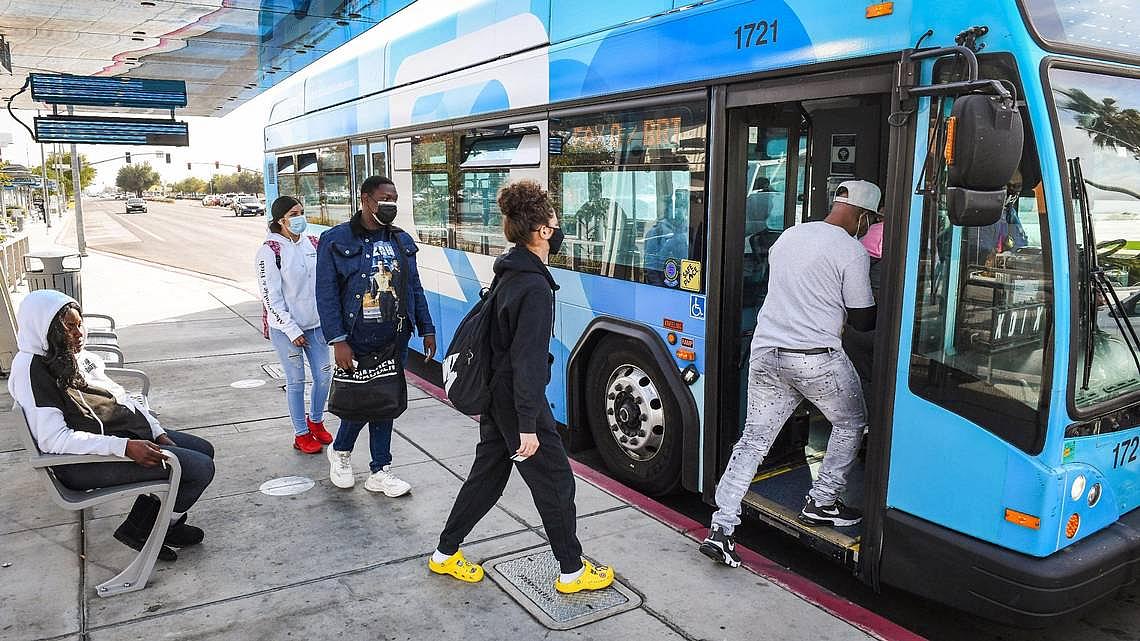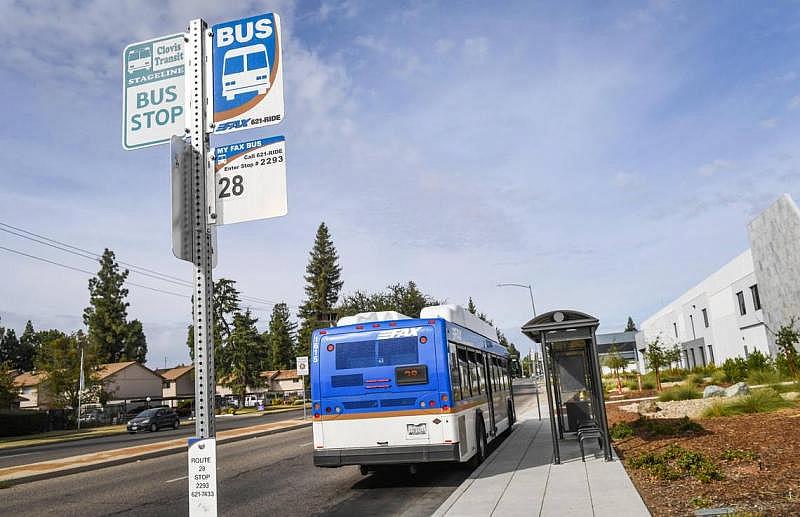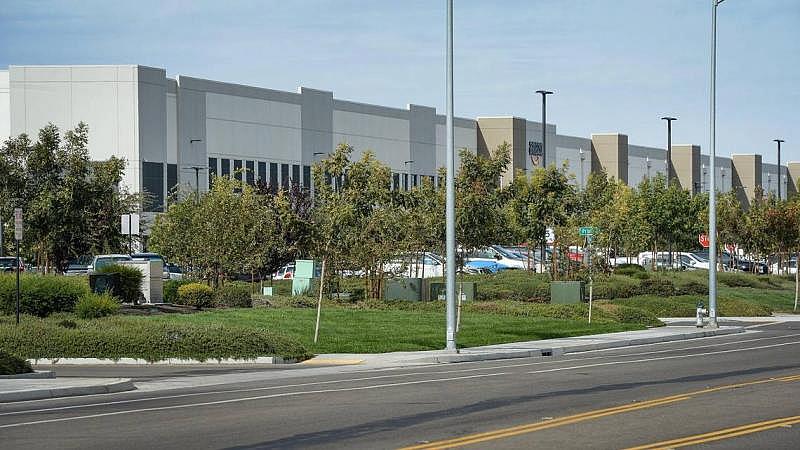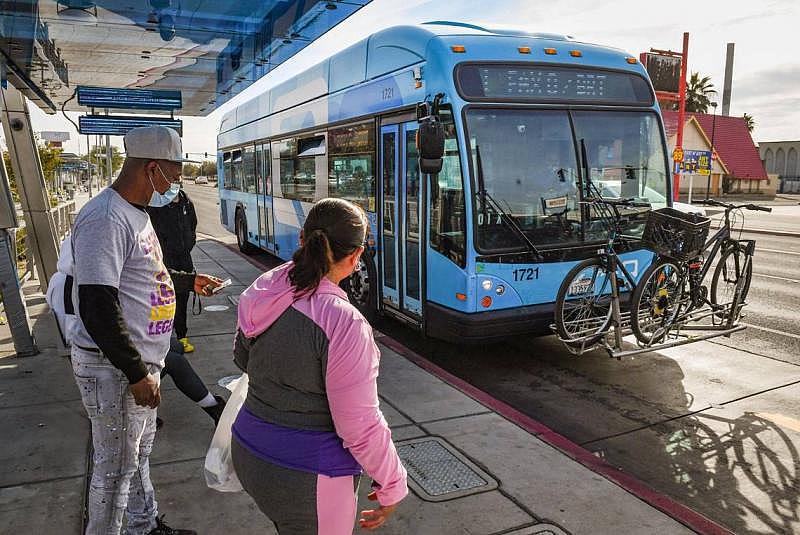Are Fresno’s car-less residents being left behind? What it means to our community
This story is part of a series produced as a project for the USC Annenberg Center for Health Journalism’s 2021 California Fellowship.
Other stories includes:
What’s Measure C? Why Fresno County could be voting on another sales tax measure
This Week in Fresnoland: What is transportation justice?
Left out and overlooked: How rural Fresno County roads and transit are neglected
‘There’s a big need.’ How a lack of public transit impacts people in rural Fresno County
Fresno County’s rural residents face transportation gaps. How electric rideshare programs help

Passengers board a FAX bus at a stop near Manchester Center in Fresno. In Fresno County, about 65% of all jobs are within a 10-minute walk to a bus stop, according to census data retrieved for Fresnoland by the Fresno Council of Governments. But commute times for bus riders in Fresno are nearly double what car owners deal with
CRAIG KOHLRUSS CKOHLRUSS@FRESNOBEE.COM
West Fresno resident Trenisha McFarland relies on a bus ride to get to Fresno State where she’s a third-year student in criminology and to work not far from the university campus.
McFarland’s two children, 7 years and 5 months, ride alongside her to school and their daycare arrangements.
To make sure she’s on time for her 8 a.m. class, McFarland must get out of bed by 4 a.m. to bathe, wake, dress and feed the children and walk a few blocks to her bus stop. If she misses the 6 a.m. bus, her whole day is shot. The next bus arrives half an hour later, and she would miss her first class, and her 7-year old would be late for school.
“If the bus is running late, that makes me late, you know,” she said. “For my important things I have to do, I have no choice.”
McFarland, 28, remembers a few times, on her way to medical appointments during her pregnancy, the bus running late and her anxiety about how the doctor’s office would react. To make matters worse, the bus is often further delayed by a freight train that seems to go on forever. “When you keep looking up there and being delayed and things like that,” she said, “that’s just really frustrating.”
Many think of sprawling, car-oriented Fresno as a place where you can’t live without a car, and yet McFarland’s experience is common for residents of southwest Fresno — where nearly 40% of households don’t own a vehicle. Nearly 9% or 26,000 Fresno County households don’t have access to a car.
That number doesn’t take into account households with several people under one roof sharing a car; or whether the car a family owns is even reliable.
Having a reliable car — or a reasonable transit commute — is one of the most important factors in determining whether someone can climb the economic ladder, according to 2015 research from economists at Harvard and UC Berkeley.
Decades of freeway building and road widening has given Fresno County drivers and suburbanites some of the shortest commutes of any major American city — 24 minutes on average, according to census data. But commutes for bus riders are 39 minutes on average, as more homes and jobs spread to the fringe of the city.
//For residents of Fresno and the surrounding rural areas, getting — and keeping — a good job without a reliable vehicle can prove difficult.
“There’s a very robust connection between having a car and having a job,” said Evelyn Blumenberg, director of the Lewis Center for Regional Studies and a professor of urban planning at UCLA.
The city of Fresno’s transit agency, Fresno Area Express, is betting on more frequent service to improve commute times and increase ridership in order to serve their core customers. But as more jobs and homes get built in far-flung suburbs, will that be enough to improve access for workers without a reliable car?
CAR ACCESS IMPACTS JOB PROSPECTS, MOBILITY
Irene Sanchez, a west Fresno resident, is looking for a job. She doesn’t have a car — and said in an interview that she plans to rely on her adult children to drive her to work.
In Fresno County, about 65% of all jobs are within a 10-minute walk to a bus stop, according to census data retrieved for Fresnoland by the Fresno Council of Governments.
But commute times for bus riders in Fresno are nearly double what car owners deal with.
That challenge is compounded for women, and especially mothers, who often carry the burden of taking their children to childcare, school or the doctor, said Blumenberg. Relying on a bus can make planning a sequence of several trips very challenging, especially if you’re trying to be on time to class or work.
BUS RIDERSHIP UP BEFORE PANDEMIC
After decades of declining ridership following drastic cuts in service, ridership at FAX increased consistently for the three years leading up to the pandemic, said Greg Barfield, a Fresno assistant city manager — even as many transit agencies across the U.S., including Los Angeles, saw declines.
In 2019, before the pandemic, FAX had over 11 million riders. Since March 2020, transit agencies across the country have hemorrhaged riders. FAX lost 50% of its riders during the pandemic. Clovis Roundup lost 62% of its riders.
But things are slowly changing. “I think our passenger base is coming back,” Barfield said. “But our typical passenger is a single mom, and she may not be back to work yet, with her kids just now starting school.”
Barfield said the gains in ridership prior to the pandemic came after FAX increased the number of buses running on several routes. Buses run now on 15-minute intervals along Blackstone, Ventura/Kings Canyon, Cedar and Shaw avenues.
Despite the bump in riders, transit is not a very popular option for Fresno County commuters, even among those who can’t afford a car. Just under 2% of workers, or just over 4,000 people, take the bus to work, compared to 5% statewide, according to census data.
MORE BUSES, MORE SERVICE
To Barfield, the pathway to continuing to build back and grow FAX’s ridership is clear: more frequency of service.
“We have one more route that’s still on 45-minute frequencies, Route 45 (Ashlan Avenue from Polk Avenue west of Highway 99 to Clovis). By the end of the year, buses will be running every 30 minutes,” he said.
The experts seem to agree that if FAX wants to improve the system for those who need it most, this is the right choice.
“Transit expansion — by increasing your operating budget — is one of the most cost effective and equitable ways to improve the transportation system now,” explained Ben Fried, communications director for Transit Center, a New York-based organization that advocates for better public transportation.
“Dollar for dollar, if you can change a route from 30-minute to 15-minute headways, that’s a dramatic effect. You get less car pollution, more household savings, and lower transportation costs.”
A FAX bus drives down South Walnut Avenue between the West Fresno Branch Library and Edison High School on Wednesday, Oct. 20, 2021. CRAIG KOHLRUSS CKOHLRUSS@FRESNOBEE.COM
But those improvements in service have limitations in sprawling regions like Fresno, UCLA’s Blumenberg said.
“If you put more transit supply in a suburban area, the effect on ridership is going to be minimal, because it’s still going to take people a long time to get to their destination,” she explained.
Instead, building a denser network of housing and jobs, close to existing transit lines, can help shorten travel distances, making transit more efficient and comparable to driving.
“Land use is key to making transit work. It does not work well with these dispersed environments, despite the money we throw at it,” said Blumenberg.
‘THE BUS DOESN’T GO THERE’
Amelia Valdez, a mother of four from southeast Fresno, takes two buses for an hour to get to her job at a McDonald’s in northwest Fresno. Without a car, she is limited in what kinds of jobs she could apply for after her kids started school again this fall.
“I would’ve applied to Amazon (distribution center in south Fresno); I could have made $16 an hour. But the bus doesn’t go there,” she explained.
West Park resident Maria Del Carmen Valencia had to walk miles to the nearest grocery store and could not work because of lack of transportation access. Many rural Fresno County residents do not have reliable access to public transportation options. BY MARÍA G. ORTIZ BRIONES | CASSANDRA GARIBAY
As Fresno and Clovis continue to grow on the fringes of the metro area, transit service is often an afterthought, leaving some people without a car unable to get to work or school.
For example, Clovis Community College opened its new campus at Willow and International avenues in 2007 and serves 13,000 students today. But 14 years after opening, students without cars are still unable to get to the campus on a bus.
FAX is planning to expand Route 3 along Herndon Avenue to the CCC campus in January. Right now, students can access the campus via vanpools that start at the River Park Shopping Center in northeast Fresno, Barfield said.
After the Fresno County Department of Social Services moved its main campus to southwest Clovis in 2018, many people were left scrambling to find a ride or pay up to $40 for an Uber to access services, like CalWORKS or SNAP. The community was not consulted about this decision — and neither were Fresno city and FAX officials, Barfield said.
“I learned about the (DSS) move in a meeting about something completely different,” Barfield said. “We obviously knew that we had to get our people to DSS no matter what, so we retooled Route 28 that used to go to Fresno State from west Fresno and re-routed it along Dakota (Avenue) to DSS.”
A FAX bus waits at a stop near the Department of Social Services facility in Clovis on Wednesday, Oct. 20, 2021. CRAIG KOHLRUSS CKOHLRUSS@FRESNOBEE.COM
That decision was not without controversy: Fresno City Councilmembers balked at the change, asking why Fresno residents should pay for an inconvenience that Fresno County officials created. But the county refused to pay for the cost of changing the transit line.
FAX service will soon be coming to Justin Garza High School in Central Unified, Barfield said. Fresno neighborhoods west of Highway 99 have long gone with sparse, if any, public transportation access.
The city of Fresno has focused a lot of energy and taxpayer subsidies to bring warehouses and distribution centers to south Fresno, where a few thousand people work today. There’s a bus stop next to the Amazon warehouse on the corner of Central and Orange avenues — but no buses actually run to it. FAX service eludes many who work or want to work at these jobs, which pay slightly higher than minimum wage.
“I’ve got the money in my bank account,” said Barfield. FAX received a grant to expand service, but a $2.8 million plan to improve Central Avenue — needed before buses can run — has been slowed due to litigation, he said. (A settlement agreement approved by the Fresno City Council in March 2021 requires the city to include pedestrian safety measures when updates are made to Central Avenue.)
Fresno City Councilmember Miguel Arias is concerned that the city will be subsidizing transit service where employers — like Amazon — could be kicking in more resources to make sure people get to work.
A FAX bus stop is expected to be constructed near the Amazon fulfillment center on Orange Avenue at Central south of Fresno. CRAIG KOHLRUSS CKOHLRUSS@FRESNOBEE.COM
WORKERS, EMPLOYERS GET CREATIVE
In lieu of more-efficient and widely accessible transit, workers and employers are forced to find different options.
Crowdsourcing funds to buy or repair a car is common on platforms like GoFundMe. More than 100 people in Fresno have listed their campaigns to get money for a car in 2021, according to a recent search.
An unexpected car breakdown can create a huge setback for many Fresno residents. Many are raising just $500-$1,000 to fix their car so they can get back to work.
Some employers, like Bitwise Industries, sponsor vanpools for employees and apprentices who are out of the reach of transit.
“I offer my guys, ‘Hey, I can pick you up, I can drop you off, I’ll get an Uber for you,’ just to make sure they can get to work,” said a representative for ValleyWide Beverage at a Nov. 16 job fair. (The nearest bus stop is at North and Elm avenues, a 32-minute walk away, according to Google.)
There are also state-funded programs, like ValleyCAN, that help people with less money swap out older, polluting cars for newer, cleaner models.
Passengers prepare to board a FAX bus at a stop near Manchester Center in Fresno on Wednesday, Oct. 20, 2021. CRAIG KOHLRUSS CKOHLRUSS@FRESNOBEE.COM
Some transit agencies, like Fresno County Rural Transit, are experimenting with ride-sharing programs for places where jobs and homes are too spread out to make a standard fixed-route bus line efficient.
Susan Handy, director of the National Center for Sustainable Transportation at UC Davis, says electric-assisted bicycles could be another solution for more-sprawling areas, especially in a flat city with a relatively moderate climate most of the year, like Fresno and Clovis. A new e-bike runs anywhere from $500 to $2,000.
Blumenberg noted that in sprawling Los Angeles, an electric car-sharing program with accessible pricing called BlueLA could show some promise. For people with lower incomes, memberships start at $1 per month and drivers pay 15 cents per mile to rent the car. But if there’s uncertainty about whether a car will be available, it makes it difficult for people to rely on if they need to get to work.
Public transit will have to evolve to survive, but how much can better transit fix for a region that keeps growing out?
“Cities have adopted policies that make it really easy for people to travel by car. And then we expect transit to solve our problems,” said Blumenberg.
Fresnoland editor Dympna Ugwu-Oju contributed to this story.
[This article was originally published by The Fresno Bee.]
Did you like this story? Your support means a lot! Your tax-deductible donation will advance our mission of supporting journalism as a catalyst for change.

